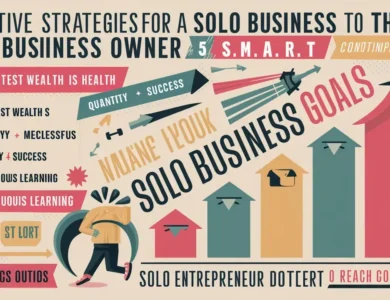Top 8 Business Strategies for Fast Growth

Fast growth is every business dream but this path requires much effort and investment. Got both? Well, there are still a few things to be taken care of to pave the road ahead. For starters, you will need a complete roadmap, including what to do and when to do it if you want rapid success for your business.
However, the competition is higher than ever now and you will need a strategic approach to planning everything. To assist you with that, these are the top 8 business strategies for fast growth.
1 – Know Your Audience
First, you need to clarify who your targeted audience is, especially their age and interests. Because, without having a clear understanding of who needs your service or product, you will be selling at the wrong table. This will lead to useless leads with less or no interest in what you are offering and it won’t do any good to your business. That’s why, you should:
- Built customer relationships: Increase loyalty through the best service possible, personalized experiences, and discounts. Also, note that upselling and cross-selling to existing customers is a great course of action for your business.
- Gather customer feedback: Regularly collect user feedback through surveys, reviews, and direct interactions. Afterward, use the gathered information to refine your offerings and also address pain points.
- Become customer-centric: Make sure that your entire organization aligns around serving your customers the best. Not to mention, empower your employees to make decisions that prioritize their needs to create a healthy work environment.
2 – Build a High-Performing Team
Next up is to build a high-performing team that is devoted to the same goal as you and is motivated to strive. This will make things a lot easier for you as all the operations will be divided and taken care of by the ones capable of doing it. However, be careful while choosing the right fit for your business as it can make or break the whole team. So, to build such a team, you should:
- Hire the best talent: Attract and retain top performers by offering competitive compensation, creating a positive work environment, and providing growth opportunities.
- Invest in employee training and development: Equip your team with the skills and knowledge needed to excel in their roles and adapt to changing demands.
- Empower your employees: Give your team the autonomy and trust to make decisions and take ownership of their work.
3 – Utilize Technology Strategically
From the very start to managing operations once everything is streamlined, technology has made it easy for entrepreneurs to handle their tasks. Utilizing technology strategically is a great way to get the maximum out of your efforts as it sets you at the right pace and mindset if used properly. There are fewer chances of making mistakes if you were to get the help of business tools and monitor your productivity. For starters, you can:
- Automate tasks: Free up human resources by automating repetitive processes with robust software and tools.
- Better Decision Making: Utilize data analytics to gain insights into customer behavior, market trends, and operational efficiency.
- Get Better Outcomes: Choose tools that streamline operations, enhance customer experience, and support your growth goals.
4 – Expand your Product or Service Offerings
If you are done with creating a high-performing team and utilizing technology effectively, it is time to expand your offerings. Always remember that the more you put out to the audience the more you target, so be diverse when offering what you have.
While it’s better to have one specific offering and not be the jack of all, you shouldn’t be afraid of expanding if you have the right team for the job. In short:
- Develop new products or services: Conduct market research to identify unmet needs and opportunities for innovation.
- Offer different tiers or variations: Understand diverse customer segments with products or services tailored to their specific requirements and budgets.
- Bundle your offerings: Create attractive packages that combine complementary products or services, offering greater value to customers.
5 – Optimize your Marketing and Sales Funnel
A great marketing and sales funnel is the lifeblood of any fast-growing business. It’s the pathway that guides potential customers from awareness to purchase and ultimately, into loyal advocates. Here’s how to optimize yours:
Attract (Top of the Funnel):
- Content marketing: Create valuable, informative, and engaging content that attracts your target audience and educates them about your offerings. Utilize various formats like blog posts, infographics, videos, and social media content.
- SEO: Optimize your website and content for relevant keywords to improve organic search visibility and attract potential customers searching for the solutions you provide.
- Paid advertising: Utilize platforms like Google Ads, Facebook Ads, and LinkedIn Ads to target specific demographics and interests with laser-focused campaigns.
- Social media marketing: Actively engage on social media platforms where your target audience is present. Share valuable content, participate in relevant conversations, and run targeted social media ads.
Engage (Middle of the Funnel):
- Lead capture: Offer valuable resources like e-books, webinars, or free consultations in exchange for email addresses or contact information.
- Email marketing: Nurture leads with targeted email campaigns that educate them about your products or services, offer relevant solutions to their problems, and ultimately guide them toward a purchase.
- Landing pages: Create high-converting landing pages with clear calls to action for your specific marketing campaigns.
- Webinars and live events: Host webinars or live events to showcase your expertise, connect with potential customers, and answer their questions in real time.
Convert (Bottom of the Funnel):
- Sales process optimization: Analyze your sales process to identify and eliminate bottlenecks. Train your sales team on effective closing techniques and objection handling.
- Personalization: Personalize your sales offers and communication to resonate with individual customer needs and preferences.
- Free trials or demos: Offer free trials or demos of your products or services to allow potential customers to experience the value firsthand.
- Strong customer support: Provide excellent customer support throughout the sales process and beyond to build trust and encourage repeat business.
6 – Prioritize Customer Retention
Customer retention is a great tool to have in your arsenal if you want to achieve big. Building trust by providing the best is what separates a great business from the standard one and that’s where you should be putting your efforts in.
Acquiring new customers is important for growth but always remember, retaining the existing ones is more crucial. Here’s how to do that:
- Deliver exceptional customer service: Respond promptly to inquiries, resolve issues efficiently, and go the extra mile to exceed expectations.
- Implement a loyalty program: Reward repeat customers with discounts, exclusive offers, and special perks.
- Gather feedback and act on it: Regularly solicit feedback from customers and use it to improve your products, services, and overall experience.
- Stay connected: Keep your customers engaged through regular communication, updates, and valuable content.
7 – Continuously Adapt and Evolve
Once every operation is streamlined and things go smoothly, your next course should be focused on being adaptable and evolving. Why? This will keep you head-to-head with the competitors and with the industry standards, making your offerings relevant and appealing. Not sure where to start? Here’s how:
- Have a growth mindset: Create a culture based on innovation and experimentation within your company and encourage your team to test new ideas, learn from failures, and adapt to changing market trends.
- Stay updated on industry trends: Actively monitor industry trends, competitor activities, and technological advancements and be consistent and adaptable to changing dynamics to stay ahead of the curve.
- Gather customer feedback: Regularly solicit customer feedback through surveys, reviews, and direct interactions and use this feedback to improve your products, services, and overall customer experience.
8 – Build a Strong Brand Identity
Having a strong brand identity is an important thing to have in order to achieve success in the competitive business landscape of today. This sets your service apart from the competition and builds credibility in the eyes of the user. To achieve such prestige, you need to:
- Define your brand values and mission: Clearly articulate what your brand stands for and how it makes a difference in your customers’ lives.
- Develop a consistent brand voice and visual identity: Use consistent messaging, fonts, colors, and imagery across all marketing materials and customer touchpoints.
- Create a positive brand experience: Deliver excellent customer service, exceed expectations, and build positive word-of-mouth through satisfied customers.
- Actively manage your online reputation: Monitor online reviews and respond to negative feedback promptly and professionally.
Ending Note
Achieving a business goal is nothing like a low-hanging fruit, if you are not up to the task. Remember you need to be consistent and realistic on every step you take and only then you will achieve what you are looking for. That’s why, put effort and time into the strategies we just discussed and you will be off to a great start, that’s a promise.



